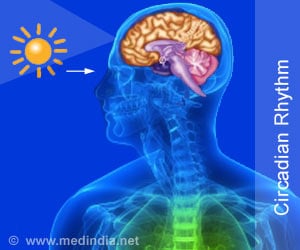Highlights
- The suprachiasmatic nucleus (SCN) functions as the body’s master clock regulating and controlling functions like sleep and temperature.
- Deleting the gene LHX1 from cells that make up the SCN, caused severe disruption of the circadian rhythm.
- Though impaired SCN affects core body temperature, it is also responsible for the temperature resistance of circadian rhythms.
SCN functions as a master clock. It uses light to synchronize body’s rhythms with day and night. It directly controls sleep-wake cycle and indirectly controls other process like body’s thermostat, hunger and thirst.
But the importance of SCN to light’s immediate effect on regulation of sleep was yet to be determined.
"If you surgically removed the SCN in mice, their sleeping and waking were no longer immediately influenced by light, but you can't remove the SCN without also severing the optic nerve that brings light information to it from the retina. So no one knew if this resistance to light was due to the missing SCN or the missing optic nerve," says Blackshaw.
In earlier experiments, when the researchers were trying to identify genes involved in the development of the mouse hypothalamus, the area of the brain that includes the SCN, they identified one such gene, dubbed LHX1, that seemed to be the earliest to "turn on" in the development of the fetal SCN.
In the new round of experiments, when the scientists deleted LHX1 just from cells that make up the SCN, the circadian rhythms in mice were severely disrupted.
The sleep pattern, including the time and duration of sleep, of the mice became random after deletion of LHX1. They slept for the same amount of time, about 12 hours each 24-hour period, like normal mice, but without a pattern to the cycle.
"This experiment showed that the SCN is critical to light's immediate effect on sleep," says Blackshaw.
Effect on Core Body Temperature
The core body temperature did not fucntion normally in the SCN-impaired mice.
In humans, the average body temperature for humans is 37 degrees Celsius, that fluctuates throughout the day and reaches it peak in the afternoon and lowest just before dawn. A similar pattern occurs in mice.
But cycles in the core body temperature is not generally disturbed by large temperature changes and that explains why fever does not cause a jet-lag.
Experiments in mouse are not sufficient to prove if the SCN was responsible for this resistance to strong temperature changes in living animals.
To test if mice might be able to return to normal temperature cycles if given pulses of heat, researchers injected the mice, kept in dark, with a molecule found in bacterial cell walls, which makes them run a fever.
As suspected, their regular core temperature cycling came back.
"These results suggest that the SCN is indeed responsible for the temperature resistance of circadian rhythms in live animals, and it shows us how important SCN coupling is," says Blackshaw. "It also bolsters the idea that the body's other physiologic cycles, such as hunger and hormone secretion, are synchronized by the SCN through its regulation of core body temperature."
Additional experiments have helped to identify several molecules that may be directing these vital signals and the research team plans to follow up by studying each molecule to determine their roles.
Their study will be published in the journal Current Biology.
Source-Medindia















